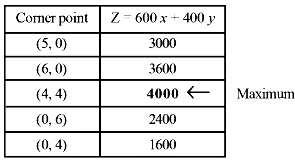Let x and y be the number of items M and N respectively. Total profit on the production = Rs (600x+400y) Mathematical formulation of the given problem is as follows: Maximise Z=600x+400y subject to the constraints: x+2y≤12 (constraint on Machine I) ... (1) 2x+y≤12 (constraint on Machine II) ... (2) x+5/4y≥5 (constraint on Machine III) ... (3) x≥0,y≥0... (4) Let us draw the graph of constraints (1) to (4). ABCDE is the feasible region (shaded) as shown in below figure determined by the constraints (1) to (4). Observe that the feasible region is bounded, coordinates of the corner points A, B, C, D and E are (5, 0 ) (6,0),(4,4),(0,6) and (0, 4) respectively. Let us evaluate Z = 600x+400y at these corner points.


We see that the point (4, 4) is giving the maximum value of Z. Hence, the manufacturer has to produce 4 units of each item to get the maximum profit of Rs 4000.


Comments